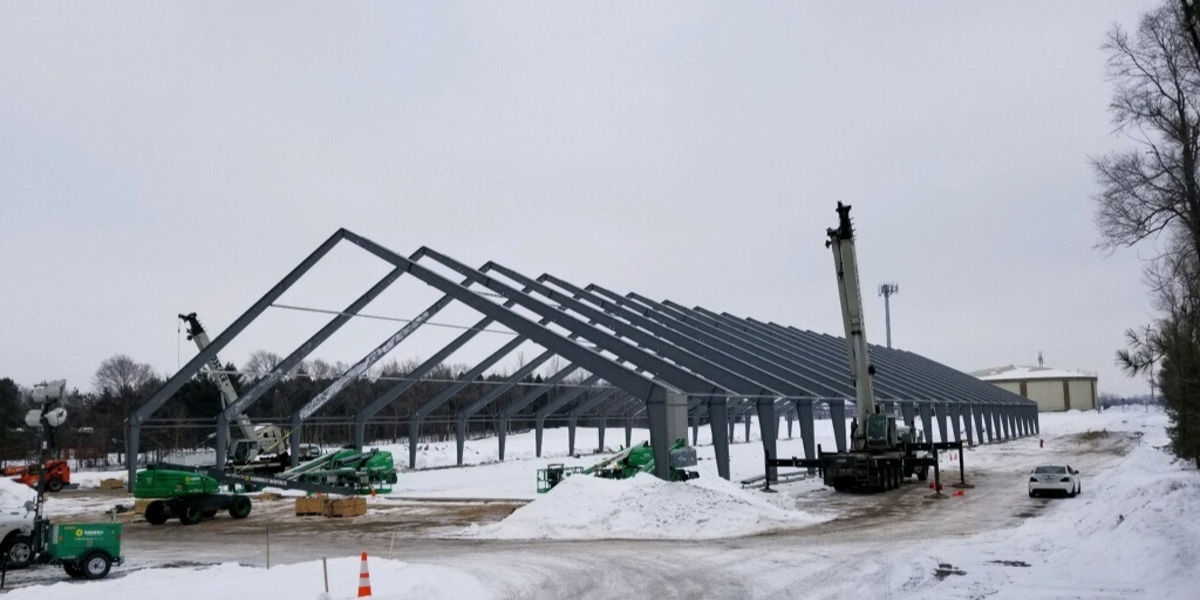Fabric Structures for Extreme Conditions

Natural disasters – including earthquakes, snow and wind – happen all over the world, and usually with very little warning.
When is the best time to evaluate how your building will perform in a disaster? Before construction begins. Legacy’s team will use engineering best practices and proven principles to make a building that is safe and long-lasting in any conditions.
Natural Disaster Resistant Construction
There is no building type that is immune to natural disasters. Building codes and local regulations are in place to help structures withstand the expected impact of weather events.
All Legacy buildings are designed to comply with these codes and regulations. In a disaster, the buildings are expected to perform as well as other structures in the area.
Wind Resistant Buildings
Legacy buildings are solid and sturdy during windstorms. The buildings do not sway or rock during a wind event.
Building regulations dictate both the windspeed and exposure for the building. Legacy’s engineering team uses standardized software programs and manual checks to ensure the building frame and secondary bracing meet these requirements.
With our patented attachment system, the roof is divided into individual panels that are each permanently affixed to the frame. This system prevents the fabric from lifting or tearing when exposed to high winds.
With the monocover design common to other fabric buildings, the roof is one large panel that is attached only at the end frames. Often in strong winds, the fabric is likely to lift off the supports, experience significant pressure and ultimately tear – leaving the contents of your building vulnerable to the elements.
Legacy has completed testing on our fabric attachment system, especially for high wind locations. Part of this testing included the extensive testing required to achieve Florida Product Approval. Read more.
Earthquake-Resistant Building Technology
Seismic ratings determine the building’s ability to withstand earthquakes and other seismic activity. Legacy buildings meet or exceed seismic standards as required.
Fabric panels are permanently welded together, without small fasteners holding them together or attaching them to the frame. These lifelong welds are not damaged by the vibrations caused by earthquakes.
Learn more about Legacy buildings in severe weather conditions.
The flexible nature of the fabric also allows some movement to the frames without damaging the fabric panels. Legacy does not rely on the fabric as a lateral brace for the building, with all the movement on the frames absorbed by the foundation.
Best Roof Design for Snow
Snow accumulation adds significant weight to rooftops in snowy areas. Legacy buildings in snow zones have a roof slope of at least 4/12 to encourage snow to slide onto the ground below.
ExxoTec™ PVC fabric has a smooth surface, allowing snow to slide off faster. The surface of the fabric has special protectants to preserve the smooth surface throughout the life of the building. Combining fabric with the angle of the roof makes an efficient system to remove snow from the top of the building before it causes damage.
Learn more about the engineering behind fabric buildings with this webinar.
Even with the slide effect, it is important for the roof design to safely accommodate the added weight of the snow. Legacy buildings do not take engineering shortcuts or reductions in the load. This ensures the safest possible building in the event of extreme snow build-up.
Rebuilding After a Natural Disaster
When disaster does cause damage, Legacy buildings are easily repairable. We employ a team of fabric structure experts who travel to any location to assess and repair any damage. Some simple repairs and small rips may even be repaired by the building owner.
Legacy’s team manufactures building covers onsite, creating replacement covers as needed. By controlling the entire process, Legacy shortens the timeline for manufacturing and replacing the custom cover.
No matter the conditions in your area, a Legacy building can be customized for you. Discover more reasons fabric is an ideal building material choice when durability is a top priority.
Subscribe to our Blog
Recent Posts
- 5 Factors Every Project Owner Should Consider Before Approving Building Materials
- The 20-Year View: How Material Choices Impact Long-Term Operational Costs
- Climate Resilience in Commercial Construction: Why Traditional Methods May Not Be Enough
- Speed and Quality: The Role of Hybrid Building Materials
- Beyond the Bleachers: Designing Visually Striking Sports Facilities
